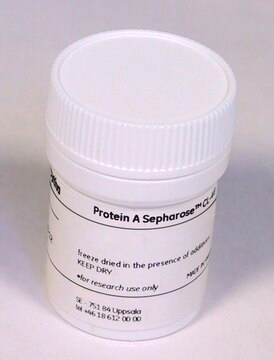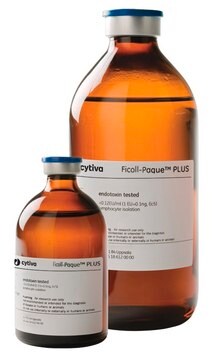P3296
Protein G Sepharose™, Fast Flow
recombinant, expressed in E. coli, aqueous ethanol suspension
Synonim(y):
Protein G-Agarose, Fast Flow from Streptococcus sp.
About This Item
Polecane produkty
rekombinowane
expressed in E. coli
Postać
aqueous ethanol suspension
klasy chemiczne analitów
proteins (Immunoglobulins of various mammalian species)
zakres etykietowania
~2 mg per mL
metody
affinity chromatography: suitable
macierz
Sepharose 4B Fast Flow
aktywacja macierzy
cyanogen bromide
MAR
amino
spacer macierzy
1 atom
temp. przechowywania
2-8°C
Szukasz podobnych produktów? Odwiedź Przewodnik dotyczący porównywania produktów
Opis ogólny
P3296-5Ml′s updated product number is GE17-0618-01
Zastosowanie
Postać fizyczna
Uwaga dotycząca przygotowania
Informacje prawne
Hasło ostrzegawcze
Warning
Zwroty wskazujące rodzaj zagrożenia
Zwroty wskazujące środki ostrożności
Klasyfikacja zagrożeń
Flam. Liq. 3
Kod klasy składowania
3 - Flammable liquids
Klasa zagrożenia wodnego (WGK)
WGK 3
Temperatura zapłonu (°F)
115.0 °F - closed cup
Temperatura zapłonu (°C)
46.1 °C - closed cup
Certyfikaty analizy (CoA)
Poszukaj Certyfikaty analizy (CoA), wpisując numer partii/serii produktów. Numery serii i partii można znaleźć na etykiecie produktu po słowach „seria” lub „partia”.
Masz już ten produkt?
Dokumenty związane z niedawno zakupionymi produktami zostały zamieszczone w Bibliotece dokumentów.
Protokoły
To determine the molecular weights of protein antigens, to study protein/protein interactions, to determine specific enzymatic activity, to monitor protein post-translational modifications and to determine the presence and quantity of proteins.
Techniki określania masy cząsteczkowej antygenu białkowego, interakcji białkowych, aktywności enzymatycznej i modyfikacji potranslacyjnych.
Nasz zespół naukowców ma doświadczenie we wszystkich obszarach badań, w tym w naukach przyrodniczych, materiałoznawstwie, syntezie chemicznej, chromatografii, analityce i wielu innych dziedzinach.
Skontaktuj się z zespołem ds. pomocy technicznej







